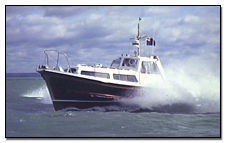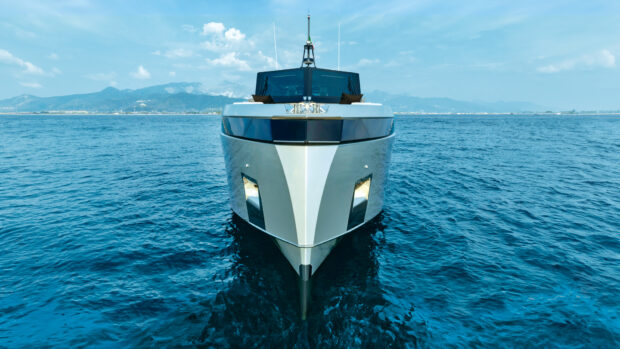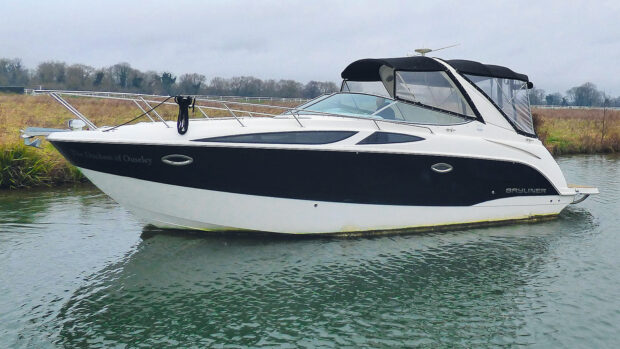For a boat with working-class roots, the Nelson 34 attracts more than its share of admiring glances. But, as Starlet confirms, the tried and tested hull can play as well.
For a boat with working-class roots, the Nelson 34 attracts more than its share of admiring glances. But, as Starlet confirms, the tried and tested hull can play as well.
The Nelson 34 is a familiar sight to thousands of boaters. Designed by the late Peter Thornycroft, the originator of the Nelson Range, it is the archetypal police boat in the same way as her big sister, the Nelson 40, is the archetypal pilot boat.
Motor cruiser versions of the 34 are rare, but Starlet is even more so. In the 1960s and early 1970s most Nelson 34s were laid up by Tyler Mouldings in Kent and fitted out by one of a variety of yards. Starlet was built in 1967 as Blue Slipper for one of the Tyler family and fitted out in-house.
In 1975 Blue Slipper went out to Italy, where she remained for nearly 20 years in the hands of five successive owners until a British enthusiast found her rotting away in Portofino. He brought her back to the UK, intending to restore her, but soon thought better of the idea and put her up for sale.
David and Judy Morgan found the now-renamed Starlet at Berthons, in Lymington, in 1996. “We instantly fell in love with her,” said David. He points to the cushions, which have a picture of a sailing ship called Charles W. Morgan: “She even had our name on.”
They weren’t even put off by a damning survey. “She was in an awful state,” says David. “It was the worst survey I have ever had on a boat.” She was suffering from electrolytic corrosion and osmosis (“off the scale”) below the waterline, and the integral GRP fuel tanks were leaking diesel through the hull. There was no cover for the cockpit, so water had pooled on the cockpit seats, rotting them and dripping through on to the engines underneath. The cast iron manifolds had lost all their carbon and turned into a filigree that could be cut with a knife.
The cathodic protection was almost non-existent. One anode had fallen off, and the other was uncoupled so there was no internal bonding. The props had suffered most, with holes right through their blades.
The Morgans bought Starlet in June 1996 and immediately began work. She was lifted out, the gel-coat was removed and she was left to dry out, with a steam clean at the end of each week. At the end of six weeks there were still a few patches of osmosis, which were removed with infra-red treatment. The integral tanks were repaired with epoxy and glass inside and out.
Although Nelsons have always been heavily laid up, David decided that it would be a good idea, while the gelcoat was off, to beef up the hull further. Two layers of heavy woven glass cloth were applied on top of the existing laminate, and finished off with five coats of anti-osmosis epoxy.
The engines, a pair of naturally aspirated 110hp Thornycroft diesels, needed a lot of work. Both manifolds and heat exchangers were removed and replaced with Bowman combined manifold/HE units. Alternators and starter motors were replaced, and a new cylinder head fitted to one engine. The
V-drive gearboxes were in reasonably good condition, requiring only replacement seals, but the alignment of the port shaft turned out to be a quarter of an inch out of true.
Inside the boat, fortunately, there was less to be done. Aware that they were working on the boss’s own motor cruiser, the Tylers staff who fitted Blue Slipper out had done a superlative job. Every locker door has a teak grating made with mathematical precision a total of 26 throughout the boat which has prevented any build-up of moisture inside. There are other nice touches: an engaged/vacant barrel lock on the loo which switches on an extractor fan when slid home, parallelogram-shaped drawers under the forward bunks following the line of the vee-berths and, throughout, the sort of carefully considered stowage that you would expect in a boat built for all weathers.
The foam upholstery was still in good condition, but needed re-covering. David also fitted a diesel-powered 2.5kW Taylor cabin heater, and a calorifier: the boat had previously had no hot water supply.
On deck, the most pressing task was to prevent a recurrence of the problems with water ingress. Two covers were made, one to seal in the open-backed wheelhouse and the other a hooped canopy covering the whole aft cockpit.
With their powerful semi-displacement hulls, Nelsons have a reputation as wet boats. Under way at Speed, visibility is limited to what can be seen through the spinning Kent Clearview screen invented before World War II but still the only effective solution to water coming green over the bow. “So much water comes on board, it’s almost impossible to stop it getting in,” says David, “but we have reduced it a large amount.” He has increased the size of the drain holes on the wheelhouse roof and fitted spray guards in front of the cover to prevent water sluicing past the seal. When the Morgans bought Starlet she had just 2,500 hours on the clock, relatively little for a boat over 30 years old. There were few of the extras expected on a modern motor cruiser the only piece of electronic kit on board was a Humminbird echo sounder/fishfinder so David has now fitted a Furuno radar and GPS navigator, an Autohelm autopilot, a traditional big green Sailor VHF and a pair of davits to take the Avon tender.
The bill for renovating and repairing Starlet so far totals around £30,000 slightly more than David paid for the boat in the first place. Fortunately, there is only one more major job on the list: the Perspex windows, now three decades old, are suffering from UV degradation and need to be replaced.
In the two years since they relaunched the boat, David and Judy have put almost 300 hours on the engines, cruising both summer and winter from their base in Cowes. She is the ideal boat for them positively luxurious for two, but capable when necessary of accommodating their daughter, son-in-law and, thanks to the new cockpit cover, two children. She cruises at 14 knots at 2,000rpm, with a top Speed of 19 knots, and averages 7gph.
Most importantly, however, Starlet perpetuates the image of the Nelson as a sailing man’s motor boat. David himself is a sailor, and used to run his own sailing school. He still feels an affinity for the rag-and-stick brigade: “We don’t have to be ashamed of parking a Nelson in a line of yachts.”
Market report
Many Nelson 34s were built by the original yard of Keith, Nelson & Co, but there are plenty of models fitted out by other yards. There is no shortage of buyers, but prices should reflect the state of the boat: a short-cabin, extended-wheelhouse version put on the market recently at £45,000 is now open to reasonable offers. David Morgan recognises that the near-£60,000 he will have spent on Starlet is more than her realisable value. But he has no intention of selling her.
Nelson Owners’ Club
The Nelson Boat Owners’ Club is run by Simon Mayes of Nelson Engineering of Bembridge, which is on the site of Keith, Nelson & Co, and Simon’s own office is the one used by Peter Thornycroft. The club has about 90 members, and puts on a rally in the Solent every summer. Contact: Nelson Boat Owners’ Club, Nelson Yard, The Embankment, Isle of Wight PO35 5NR. Tel: 01983 872306. Fax: 01932 875100.
Data
LOA 34ft 0in (10.36m)
Beam 9ft 6in (2.90m)
Draught 3ft 3in (1.0m)
Fuel capacity 2 * 75gal (2 * 330lt)
Water capacity 50gal (220lt)
Accommodation
Sleeps four to six: forecabin with vee-berths; toilet/shower; saloon with central table and bench seats/berths; galley; wheelhouse; cockpit provides further two occasional berths under canopy.
Engines
Twin Thornycroft 110hp diesels
Built
From mid-1960s mouldings still available
Designer
Peter Thornycroft
Builder
Tyler Mouldings, Tonbridge, Kent









